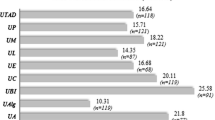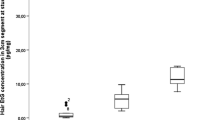Abstract
Aims
Small children are expected to be abstinent from alcohol, and children’s hair is frequently used as the blank matrix for calibration of the alcohol consumption marker ethyl glucuronide (EtG). The basal EtG concentrations of total abstainers were described to be 0.3–2.1 pg/mg (Pirro et al. 2013). It is examined whether this assumption is valid for children from families with addiction background.
Methods
In a social support system for families with drug and/or alcohol addicted parents, 161 hair samples from 126 children (age 1–14 years, hair segment 0–3 cm) were analyzed for EtG by a validated LC-MS/MS method (LOD 0.56 pg/mg, LLOQ 2.3 pg/mg). For comparison, ethyl palmitate (EtPa) was measured and hair samples from parents were included. EtG ≥ 3 pg/mg was considered as an alarming result for children.
Results and discussion
EtG concentrations between 3.0 and 42.6 pg/mg (mean 9.55 pg/mg, median 6.40 pg/mg) were measured for 25 samples (15.5%, age 22 × 1–5 years, 3 × 9–11 years). Elevated EtPa (0.15–0.46 ng/mg) was found in 6 samples and cocaethylene (0.02–0.07 ng/mg) was detected in 5 samples with high cocaine findings. Hair results of one or both parents indicated drug abuse in 12 from 14 cases (85.7%) if both parents were tested.
Conclusion
Although accidental or voluntary intake of alcoholic beverages cannot be excluded, the external contamination of children’s hair by EtG-containing wine and sweat or urine of the alcohol abusing parents is assumed to be the most probable explanation for the positive EtG results in hair of 1–5-year-old children.

Similar content being viewed by others
References
Wang X, Drummer OH (2015) Review: interpretation of drug presence in the hair of children. Forensic Sci Int 257:458–472
Pragst F, Broecker S, Hastedt M, Herre S, Andresen-Streichert H, Sachs H, Tsokos M (2013) Methadone and illegal drugs in hair from children with parents in maintenance treatment or suspected for drug abuse in a German community. Ther Drug Monit 35:737–752
Pragst F, Hastedt M, Krumbiegel F, Herre S (2015) Hair analysis as a diagnostic and forensic tool in a social support system for families with underage children and drug abusing parents: four year experience. Arab J Forensic Sci Forensic Med 1(2):180–193
Pragst F, Krumbiegel F, Thurmann D, Westendorf L, Methling M, Niebel A, Hartwig S (2019) Hair analysis of more than 140 families with drug consuming parents. Comparison between hair results from adults and their children. Forensic Sci Int 297:161–170
Pragst F, Suesse S, Salomone A, Vincenti M, Cirimele V, Hazon J, Tsanaclis L, Kingston R, Sporkert F, Baumgartner MR (2017) Commentary on current changes of the SoHT 2016 consensus on alcohol markers in hair and further background information. Forensic Sci Int 278:326–333
Society of Hair Testing: 2019 Consensus for the use of alcohol markers in hair for supporting the assessment of abstinence and chronic alcohol consumption. https://www.soht.org/images/pdf/Revision_2019_Alcoholmarkers.pdf. Assessed 22 Aug 2019
Sporkert F, Kharbouche H, Augsburger MP, Klemm C, Baumgartner MR (2012) Positive EtG findings in hair as a result of a cosmetic treatment. Forensic Sci Int 218(1–3):97–100
Arndt T, Schröfel S, Stemmerich K (2013) Ethyl glucuronide identified in commercial hair tonics. Forensic Sci Int 231(1–3):195–198
Pirro V, Di Corcia D, Seganti F, Salomone A, Vincenti M (2013) Determination of ethyl glucuronide levels in hair for the assessment of alcohol abstinence. Forensic Sci Int 232(1–3):229–236
Crunelle CL, Yegles M, De Doncker M, Cappelle D, Covaci A, van Nuijs AL, Neels H (2017) Hair ethyl glucuronide concentrations in teetotalers: should we re-evaluate the lower cut-off? Forensic Sci Int 274:107–108
Albermann ME, Musshoff F, Aengenheister L, Madea B (2012) Investigations on the influence of different grinding procedures on measured ethyl glucuronide concentrations in hair determined with an optimized and validated LC-MS/MS method. Anal Bioanal Chem 403(3):769–776
Mönch B, Becker R, Nehls I (2013) Quantification of ethyl glucuronide in hair: effect of milling on extraction efficiency. Alcohol Alcohol 48(5):558–563
Peters FT, Drummer OH, Musshoff F (2007) Validation of new methods. Forensic Sci Int 165(2–3):216–224
Peters FT, Hartung M, Herbold M, Schmitt G, Daldrup T, Mußhoff F (2009) Appendix B to the GTFCh guidelines for quality assurance in forensic-toxicological analyses. Requirements for the validation of analytical methods. https://www.gtfch.org/cms/images/stories/files/AppendixBGTFCh20090601.pdf. Accessed 28 Aug 2019
Hastedt M, Herre S, Pragst F, Rothe M, Hartwig S (2012) Workplace alcohol testing program by combined use of ethyl glucuronide and fatty acid ethyl esters in hair. Alcohol Alcohol 47(2):127–132
Casale JF, Boudreau DK, Jones LM (2008) Tropane ethyl esters in illicit cocaine: isolation, detection, and determination of new manufacturing by-products from the clandestine purification of crude cocaine base with ethanol. J Forensic Sci 53(3):661–667
Politi L, Zucchella A, Morini L, Stramesi C, Polettini A (2007) Markers of chronic alcohol use in hair: comparison of ethyl glucuronide and cocaethylene in cocaine users. Forensic Sci Int 172(1):23–27
Wood JN, Pecker LH, Russo ME, Henretig F, Christian CW (2012) Evaluation and referral for child maltreatment in pediatric poisoning victims. Child Abuse Negl 36(4):362–369
Mintegi S, Fernández A, Alustiza J, Canduela V, Mongil I, Caubet I, Clerigué N, Herranz M, Crespo E, Fanjul JL, Fernández P, Humayor J, Landa J, Muñoz JA, Lasarte JR, Núñez FJ, López J, Molina JC, Pérez A, Pou J, Sánchez CA, Vázquez P (2006) Emergency visits for childhood poisoning: a 2-year prospective multicenter survey in Spain. Pediatr Emerg Care 22(5):334–338
Kivistö JE, Arvola T, Parkkari J, Mattila VM (2008) Paediatric poisonings treated in one Finnish main university hospital between 2002 and 2006. Acta Paediatr 97(6):790–794
Pawłowicz U, Wasilewska A, Olański W, Stefanowicz M (2013) Epidemiological study of acute poisoning in children: a 5-year retrospective study in the Paediatric University Hospital in Białystok, Poland. Emerg Med J 30(9):712–716
Donovan JE, Molina BS (2014) Antecedent predictors of children’s initiation of sipping/tasting alcohol. Alcohol Clin Exp Res 38(9):2488–2495
Jackson C, Ennett ST, Dickinson DM, Bowling JM (2013) Attributes that differentiate children who sip alcohol from abstinent peers. J Youth Adolesc 42(11):1687–1695
Kłys M, Woźniak K, Rojek S, Rzepecka-Woźniak E, Kowalski P (2008) Ethanol-related death of a child: an unusual case report. Forensic Sci Int 179(1):e1–e4
Yang CC, Yang LY, Deng JF (1995) Hypoglycemia following ethanol ingestion in children: report of a case. J Formos Med Assoc 94(5):267–270
Minera G, Robinson E (2014) Accidental acute alcohol intoxication in infants: review and case report. J Emerg Med 47(5):524–526
Chikwava K, Lower DR, Frangiskakis SH, Sepulveda JL, Virji MA, Rao KN (2004) Acute ethanol intoxication in a 7-month-old infant. Pediatr Dev Pathol 7:400–402
Moss MH (1970) Alcohol-induced hypoglycemia and coma caused by alcohol sponging. Pediatrics 46(3):445–447
Engel JS, Spiller HA (2010) Acute ethanol poisoning in a 4-year-old as a result of ethanol-based hand-sanitizer ingestion. Pediatr Emerg Care 26(7):508–509
Joseph MM, Zeretzke C, Reader S, Sollee DR (2011) Acute ethanol poisoning in a 6-year-old girl following ingestion of alcohol-based hand sanitizer at school. World J Emerg Med 2(3):232–233
Hornfeldt CS (1992) A report of acute ethanol poisoning in a child: mouthwash versus cologne, perfume and after-shave. J Toxicol Clin Toxicol 30(1):115–121
Shulman JD, Wells LM (1997) Acute ethanol toxicity from ingesting mouthwash in children younger than 6-years of age. Pediatr Dent 19(6):404–408
May C (2009) The risks to children of alcohol-based hand gels. Paediatr Nurs 21(1):36–37
Tovey C, Rana PS, Anderson DJ (1998) Alcohol intoxication in a toddler. J Accid Emerg Med 15(1):69–70
Pugach S, Pugach IZ (2009) Overdose in infant caused by over-the-counter cough medicine. South Med J 102(4):440–442
Rauber-Lüthy C, Staubli G (2009) Vergiftungen beim Kind, mit besonderer Berücksichtigung der Haushaltprodukte. Ther Umsch 66(5):373–378
Rayar P, Ratnapalan S (2013) Pediatric ingestions of house hold products containing ethanol: a review. Clin Pediatr (Phila) 52(3):203–209
Anderson PO (2018) Alcohol use during breastfeeding. Breastfeed Med 13(5):315–317
Haastrup MB, Pottegård A, Damkier P (2014) Alcohol and breastfeeding. Basic Clin Pharmacol Toxicol 114(2):168–173
Voogt C, Beusink M, Kleinjan M, Otten R, Engels R, Smit K, Kuntsche E (2017) Alcohol-related cognitions in children (aged 2-10) and how they are shaped by parental alcohol use: a systematic review. Drug Alcohol Depend 177:277–290
Kronstrand R, Brinkhagen L, Nyström FH (2012) Ethyl glucuronide in human hair after daily consumption of 16 or 32 g of ethanol for 3 months. Forensic Sci Int 215(1–3):51–55
Kharbouche H, Faouzi M, Sanchez N, Daeppen JB, Augsburger M, Mangin P, Staub C, Sporkert F (2012) Diagnostic performance of ethyl glucuronide in hair for the investigation of alcohol drinking behavior: a comparison with traditional biomarkers. Int J Legal Med 126(2):243–250
Martins Ferreira L, Binz T, Yegles M (2012) The influence of ethanol containing cosmetics on ethyl glucuronide concentration in hair. Forensic Sci Int 218(1–3):123–125
Morini L, Sempio C, Moretti M (2018) Ethyl glucuronide in hair (hEtG) after exposure to alcohol-based perfumes. Curr Pharm Biotechnol 19(2):175–179
Müller A, Iwersen-Bergmann S (2018) Ethyl glucuronide in alcoholic beverages. Alcohol Alcohol 53(5):532–538
Schummer C, Appenzeller BM, Wennig R (2008) Quantitative determination of ethyl glucuronide in sweat. Ther Drug Monit 30(4):536–539
Selvam AP, Muthukumar S, Kamakoti V, Prasad S (2016) A wearable biochemical sensor for monitoring alcohol consumption lifestyle through ethyl glucuronide (EtG) detection in human sweat. Sci Rep 6:23111
Kinnamon D, Muthukumar S, Panneer Selvam A, Prasad S (2018) Portable chronic alcohol consumption monitor in human sweat through square-wave voltammetry. SLAS Technol 23(2):144–153
Høiseth G, Bernard JP, Stephanson N, Normann PT, Christophersen AS, Mørland J, Helander A (2008) Comparison between the urinary alcohol markers EtG, EtS, and GTOL/5-HIAA in a controlled drinking experiment. Alcohol Alcohol 43(2):187–191
Halter CC, Dresen S, Auwaerter V, Wurst FM, Weinmann W (2008) Kinetics in serum and urinary excretion of ethyl sulfate and ethyl glucuronide after medium dose ethanol intake. Int J Legal Med 122(2):123–128
Høiseth G, Yttredal B, Karinen R, Gjerde H, Mørland J, Christophersen A (2010) Ethyl glucuronide concentrations in oral fluid, blood, and urine after volunteers drank 0.5 and 1.0 g/kg doses of ethanol. J Anal Toxicol 34(6):319–234
Rainio J, Ahola S, Kangastupa P, Kultti J, Tuomi H, Karhunen PJ, Helander A, Niemelä O (2014) Comparison of ethyl glucuronide and carbohydrate-deficient transferrin in different body fluids for post-mortem identification of alcohol use. Alcohol Alcohol 49(1):55–59
Kummer N, Wille S, Di Fazio V, Lambert W, Samyn N (2013) A fully validated method for the quantification of ethyl glucuronide and ethyl sulphate in urine by UPLC-ESI-MS/MS applied in a prospective alcohol self-monitoring study. J Chromatogr B Anal Technol Biomed Life Sci 929:149–154
Borchgrevink CP, Cha J, Kim S (2013) Hand washing practices in a college town environment. J Environ Health 75(8):18–24
Kintz P, Villain M, Vallet E, Etter M, Salquebre G, Cirimele V (2008) Ethyl glucuronide: unusual distribution between head hair and pubic hair. Forensic Sci Int 176(1):87–90
Kerekes I, Yegles M, Grimm U, Wennig R (2009) Ethyl glucuronide determination: head hair versus non-head hair. Alcohol Alcohol 44(1):62–66
Pirro V, Di Corcia D, Pellegrino S, Vincenti M, Sciutteri B, Salomone A (2011) A study of distribution of ethyl glucuronide in different keratin matrices. Forensic Sci Int 210(1–3):271–277
Acknowledgments
The authors thank the staff at the Offices of Social Services of the Hanseatic City of Bremen for the efficient cooperation in realization of this project.
Author information
Authors and Affiliations
Corresponding author
Ethics declarations
This study was conducted according to the Helsinki ethical principles for medical research involving human subjects of the World Medical Association.
Conflict of interest
The authors declare that they have no conflict of interest.
Additional information
Publisher’s note
Springer Nature remains neutral with regard to jurisdictional claims in published maps and institutional affiliations.
Rights and permissions
About this article
Cite this article
Pragst, F., Krumbiegel, F., Thurmann, D. et al. Positive findings of ethyl glucuronide in hair of young children from families with addiction background. Int J Legal Med 134, 523–532 (2020). https://doi.org/10.1007/s00414-019-02236-5
Received:
Accepted:
Published:
Issue Date:
DOI: https://doi.org/10.1007/s00414-019-02236-5




